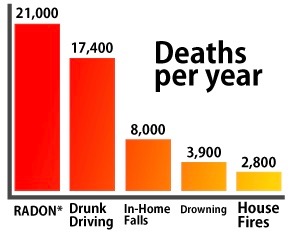Physical health is extremely important to our well-being, and many of us have several routines or behaviors we do often to stay healthy. Smoking tobacco is becoming less and less popular as more people are educated about its effects on respiratory health, and nearly everyone today knows that cigarettes and tobacco use are harmful to the body.
Smoking may be the number one cause of lung cancer in the U.S., but the second leading cause is a silent killer that’s not at the forefront of our consciousness the same way smoking is – and that’s radon. If you don’t smoke for your health, but your house is contaminated with radon, you might experience lung damage similar to smoking anyway – and its all completely preventable.
The EPA recommends always getting a radon test whether you are buying or selling your home. Radon is a odorless, colorless, and cancer causing, radioactive gas. It is a naturally occurring byproduct of the breakdown of uranium in soil, and it’s rampant in central Indiana. It’s found mostly in basements and the lower levels of the home, but it doesn’t discriminate; you can find radon gas in every home regardless of the homes features or location. No matter how new the house is, or whether or not there is a basement, there can still be deadly levels of radon present.
With proper testing, you can get the results of the radon levels in your home in as little as 48 hours. Anything over 4 pCi/L is considered dangerous, and steps should be taken immediately to remove radon from the home. The EPA claims the risk of getting cancer from radon exposure at this amount is 5 times more likely than dying in a car accident.

Even homes that have extremely high amounts of radon can be reduced to a normal, healthy level. Hire a certified radon technician to avoid testing mistakes or inaccurate readings. Let the test sit undisturbed at the lowest level of the home (either the basement or crawlspace) for at least 48 hours. Keep all doors and windows closed, only opening doors for normal entry and exit, during the entire span of the test. If a reading of more than 4 pCi/L is found, you should contact a radon-reduction specialist to remove the radon and have a radon mitigation system installed. Even if you have a mitigation system, you should still have your radon tested every few years to ensure the system still functions properly.
Especially if you live in a high-risk area, it’s important to have a raised awareness about the dangers of radon and the preventative measures that can be taken. You should absolutely have your radon tested every few years if you live in or around Central Indiana, where there are higher-than-average radon measurements. No matter how young, old, or healthy you are, and whether you smoke a pack a day or have never touched a cigarette, each person living around high levels of radon is at risk for lung cancer.

Info from: https://www.epa.gov/sites/production/files/2015-05/documents/hmbuygud.pdf
